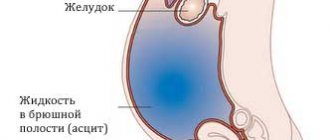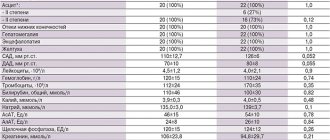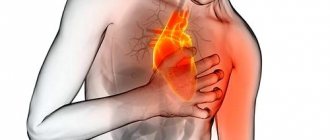General information about angina
An attack of angina develops when there is insufficient oxygen supply to the heart muscle cells. This occurs when the coronary vessels narrow and the myocardial oxygen demand increases. The attack can be triggered by physical activity, emotional stress, or going out into the cold. The pain goes away within a few minutes at rest or after taking nitroglycerin.
Under conditions of oxygen starvation, cells cannot efficiently process glucose into energy. Metabolic byproducts accumulate and “acidify” the tissues, causing severe pain. If blood flow is not restored in time, the myocardium dies and a heart attack develops.
Classification of angina pectoris
Depending on the relationship between attacks and physical activity, angina pectoris is classified as exertional or resting. The latter can occur without the influence of provoking factors, so it is more difficult to control.
Angina pectoris can be divided into two types: stable and progressive. In the first case, the frequency and strength of attacks depends on the amount of physical activity; they are easily eliminated with the help of drug therapy. Progressive angina pectoris practically cannot be corrected with pharmaceutical drugs; the frequency of attacks increases over time.
The following functional classes of stable angina are distinguished:
- Pain appears only with intense or prolonged physical activity.
- The onset of an attack when walking more than 200 m or climbing more than one flight of stairs at a normal pace. With severe emotional stress.
- Pain when walking less than 200 meters or climbing one flight of stairs at a leisurely pace.
- Seizures occur with minor physical exertion or at rest.
There is Prinzmetal's angina or spontaneous (special, vasospastic) angina - caused by a sudden spasm of the coronary arteries. Attacks develop only at rest, at night or early in the morning.
Classification of this phenomenon
The feeling of discomfort and tension has several forms of manifestation:
- first appeared;
- stable;
- progressive.
A pain attack that lasts no more than a month is considered to be a first-time occurrence. It may suddenly disappear or take on another, stable form.
Important! Many cases show that primary angina pectoris predicts acute myocardial infarction.
Pain and discomfort are regarded as more stable if they exist for a long time. It is accompanied by a non-characteristic reaction at the level of personality organization to a certain load. Can be observed for many years.
If there is an increase in the frequency, severity and duration of angina attacks at the time of performing an elementary exercise, then it is considered progressive. Thus, four functional classes of pain manifestations are distinguished. This classification was proposed by the Canadian Heart Association.
Functional class I. Seizures do not occur during daily physical activity. But at the moment of extreme physical activity that is not typical for a particular person, whether it is performed quickly or for a long time, exertional angina appears.
Functional class II. The usual physical pressure is a little limited. Attacks may occur during normal walking on a level surface over a distance of more than 200 m. Additionally, sensitivity to changes in weather conditions may be felt. If you walk against a cold wind, after a hearty lunch, or during emotional stress, you also experience pain in the chest.
FC III. Characterized by a pronounced limitation of loads. Even performing minor loads causes attacks of pain (walking distance of 100 m, climbing one flight of stairs at a normal pace). If there are additional provoking factors in the form of smoking, eating or cold wind, then the load threshold increases significantly. This degree in rare cases implies angina at rest, which occurs with psycho-emotional stress or in a lying position.
FC IV. The patient is unable to bear any load without feeling discomfort.
The functional class may depend on the amount of nitrates entering the body per day. Angina pectoris does not exceed 15 minutes in duration of pain, often increasing and reaching its peak within 30 seconds. But if the pain is caused by emotional stress, then it is present a little longer than during physical activity. In cases where the pain lasts more than 15 minutes, there is a possibility that the cause is not myocardial ischemia, or, on the contrary, its severe severity.
Risk factors for developing angina
The following factors lead to narrowing of the coronary vessels and insufficient blood supply to the myocardium:
- atherosclerosis - deposition of cholesterol plaques in the walls of blood vessels;
- hypotension ー low blood pressure;
- coronary artery thrombosis;
- age-related changes in blood vessels.
In the vast majority of cases, angina is caused by atherosclerotic lesions of the coronary arteries. It develops due to disturbances in the metabolism of cholesterol and other lipids: excess animal fats in the diet, lack of plant foods. Therefore, proper nutrition is the basis for successful prevention of angina pectoris.
Nicotine also constricts blood vessels, so smokers develop angina more often.
The risk group for the development of angina pectoris includes:
- people over 55 years of age;
- men;
- smokers;
- people who abuse alcohol and drugs;
- people with pathologies of the cardiovascular system (heart defects, heart failure);
- with pathologies of the respiratory system (bronchial asthma, chronic obstructive diseases);
- overweight.
All these factors increase the risk of developing atherosclerosis, cardiac ischemia and angina. Most of them can be eliminated through lifestyle changes.
Diagnosis of angina pectoris
Angina pectoris has a fairly typical clinical picture, so it will not be difficult for a therapist and cardiologist with experience to recognize it. To find out the cause of the attacks and determine possible treatment tactics, specialists at the Paracelsus Medical Center recommend undergoing the following examination:
- general and biochemical blood test (cholesterol and other lipid levels);
- ECG at rest and during exercise;
- echocardiography (Echo-CG);
- coronary angiography ー examination of the heart vessels using a contrast agent;
- Holter monitoring - recording of electrical impulses of the heart for 24 hours (the patient adheres to his usual routine).
Classification of heart failure
Classification of heart failure is carried out according to clinical signs, namely the ability to adequately tolerate physical activity and the symptoms that arise during this.
The classification made it possible to have a unified approach to diagnosis, as well as, more importantly, treatment of this condition. The first classification dates back to 1935, its authors were Soviet cardiologists N.D. Strazhesko and V.Kh. Vasilenko. For a long time it remained the only one, but in 1964 the NYHA (New York Heart Association) classification was adopted in New York. Cardiologists determined the functional classes of CHF on it.
Forecast and prevention of angina pectoris
The basis for preventing angina pectoris is proper nutrition and exercise. The diet should consist of proteins, vegetable fats, and complex carbohydrates. The consumption of alcohol and trans fats (fast food) should be avoided. Give preference to white meat, fish and seafood.
Regular physical activity should be present in the life of every person, this could be swimming, team sports, fitness, running or just walking. Its intensity is determined by the person’s health status; if you have chronic diseases, you should consult your doctor about the types of physical activity acceptable to you.
If you follow all the doctor’s recommendations, angina pectoris can be controlled, but, unfortunately, most patients ignore lifestyle instructions, which can lead to a worsening of the condition.
NYHA classification
In
Russian practice it is used together with the above. In addition to dividing into stages, functional classes of chronic heart failure are distinguished based on exercise tolerance:
- FC I - the patient has no restrictions on physical activity. Habitual loads do not cause pathological symptoms (weakness, shortness of breath, pressing pain, palpitations);
- FC II - load limitation is assessed as “moderate”. There are no signs of pathology at rest, but performing normal physical activity becomes impossible due to palpitations, shortness of breath, anginal pain, and a feeling of lightheadedness;
- FC III - “pronounced” limitation of exercise, symptoms are relieved only with rest, and performing even less physical activity than usual provokes the appearance of clinical signs of the disease (weakness, angina, shortness of breath, interruptions in heart function);
- FC IV - inability to tolerate even the slightest (everyday) physical activity, that is, intolerance to it. Discomfort and pathological symptoms are caused by activities such as washing, shaving, etc. Also, signs of heart failure or pressing chest pain can occur at rest.
These two classifications relate to each other as follows:
- CHF stage I - NYHA functional class 1
- CHF stage II A - NYHA functional class 2–3
- CHF II B - Stage III - NYHA FC 4
Diagnosis and treatment of angina pectoris at the Paracelsus Medical Center
When should you see a doctor?
The characteristic posture of a patient with an attack of angina pectoris: he stops abruptly, leans forward, with his right fist pressed to his chest.
If such attacks occur, as well as pain and discomfort in the heart area, it is necessary to consult a general practitioner or cardiologist for a detailed examination and selection of drug therapy.
First of all, the patient is recommended to make lifestyle adjustments:
- quitting smoking, alcohol, drugs;
- normalization of nutrition (reducing the percentage of animal fats, sugar, flour products, increasing the proportion of plant foods, fish);
- optimal mode of physical activity;
- treatment of concomitant diseases.
Drug treatment
To eliminate attacks of pain, nitrates, calcium channel blockers, and anticoagulants are prescribed.
Attention!
Medicines should be taken only on the recommendation of a doctor. Dosages are selected individually, taking into account the characteristics of the patient.
Nitrates cannot be combined with drugs used to treat sexual dysfunction (Viagra, Tadafil, etc.).
The meaning of CHF classification
Assigning a patient's status to a certain stage of CHF is important for selecting therapy, assessing its results, as well as predicting disease outcomes.
For example, stage I chronic heart failure certainly requires the use of fewer drugs and, conversely, stage III CHF forces the cardiologist to prescribe 4–5 groups of drugs. Assessing the dynamics of the functional class of circulatory failure is important, again, for selecting therapy, following a diet, and prescribing a rational motor regimen. The value of classifying the patient’s status for prognosis can be characterized by the following statistics: annually, 10% of patients die from heart failure in FC 1, approximately 20% in FC 2, about 40% in FC 3, and in FC 4, the annual mortality rate exceeds 65%.
- Diagnosis and treatment of chronic heart failure today









